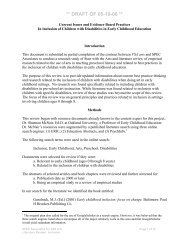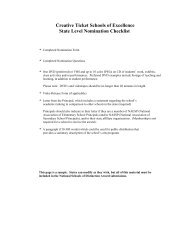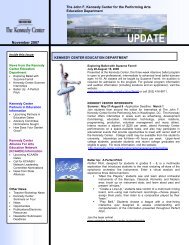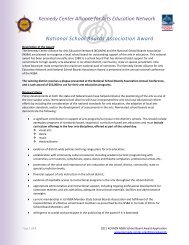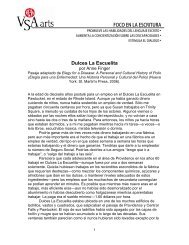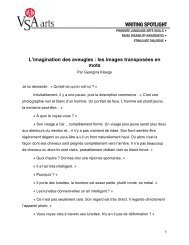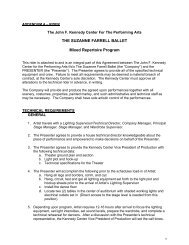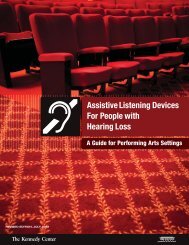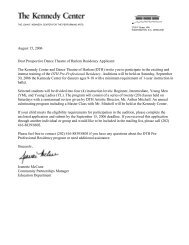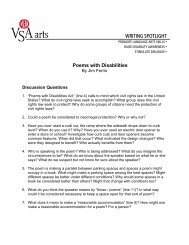Playwright Discovery Award Teacher's Guide - The John F. Kennedy ...
Playwright Discovery Award Teacher's Guide - The John F. Kennedy ...
Playwright Discovery Award Teacher's Guide - The John F. Kennedy ...
Create successful ePaper yourself
Turn your PDF publications into a flip-book with our unique Google optimized e-Paper software.
heats up quickly. Isn’t it much more interesting to<br />
say “this classroom is a furnace” rather than “this<br />
classroom is hot”?<br />
Disability as Metaphor<br />
Disability metaphors are common in the English<br />
language. <strong>The</strong>se figures of speech rely on negative<br />
associations or stereotypes to communicate<br />
meaning. For example:<br />
• His explanation of the crime was just a lame<br />
excuse for greediness.<br />
• He was blind to the possibilities of earning a<br />
college degree.<br />
• <strong>The</strong> ruler turned a deaf ear to the plight of the<br />
peasants.<br />
• Our nation is crippled by economic recession.<br />
• That homework assignment was retarded.<br />
• You are such a spaz!<br />
<strong>The</strong>se negative metaphors and clichéd<br />
expressions assume that mobility disabilities<br />
such as lameness and being crippled; sensory<br />
disabilities such as deafness and blindness;<br />
and intellectual disabilities such as retardation<br />
are inherently negative. In fact, some words like<br />
“cripple,” “spaz,” and “retard” are so inflected with<br />
hurtful histories and hateful uses that they have<br />
become taboo. Yet there is nothing inherently<br />
bad with any of these disabilities. Each of these<br />
disabilities is a mixture of good and bad, like any<br />
aspect of the human condition. Writers think<br />
carefully before using such expressions, because<br />
the character’s language choice tells the audience<br />
if they are polite, considerate, mean, or insensitive.<br />
Think about your own use of language. Do you<br />
find any of these metaphors creeping into your<br />
vocabulary in everyday life or in your writing? If<br />
you do use these and other figures of speech, can<br />
you use them to help others reflect on the impact<br />
these phrases have?<br />
Disability metaphors are also applied to<br />
characters’ entire personalities and used to<br />
suggest personality failings or negative attributes.<br />
<strong>The</strong> following are the most common ways people<br />
with disability are portrayed.<br />
Villainous Monsters often have a physical<br />
disability, such as a missing limb, or a<br />
disfigurement, such as a facial scar, that becomes<br />
a metaphor for a character’s wicked inner life.<br />
Sometimes the characters are seeking revenge<br />
against those responsible for their disabilities.<br />
Other times, the physical difference is used as a<br />
visual metaphor to convey ugliness, fear, and even<br />
terror. Such representations reinforce the belief<br />
that people with disabilities are angry about having<br />
a disability and that this makes them dangerous.<br />
In real life, fear of people with disabilities based<br />
on appearance is a major barrier to social<br />
acceptance. Examples of Villainous Monsters<br />
include:<br />
• Captain Hook in Peter Pan<br />
• Richard III in Richard III<br />
• Darth Vader in Star Wars<br />
• Two-Face in Batman<br />
• Colonel Miles Quaritch in Avatar<br />
Innocent Victims often have physical, sensory,<br />
or intellectual disabilities that serve as metaphors<br />
for a character’s psychological weakness or<br />
physical vulnerability. <strong>The</strong>se characters with<br />
disabilities are seen as weak and vulnerable or<br />
as victims who need protection or to be cured by<br />
characters without disabilities. <strong>The</strong>se characters<br />
are often portrayed as medical patients. <strong>The</strong>se<br />
characters function as moral barometers for<br />
non-disabled characters, which means that<br />
non-disabled characters’ moral goodness is<br />
established and measured by how they treat<br />
ACT I: PREPARATION 11



